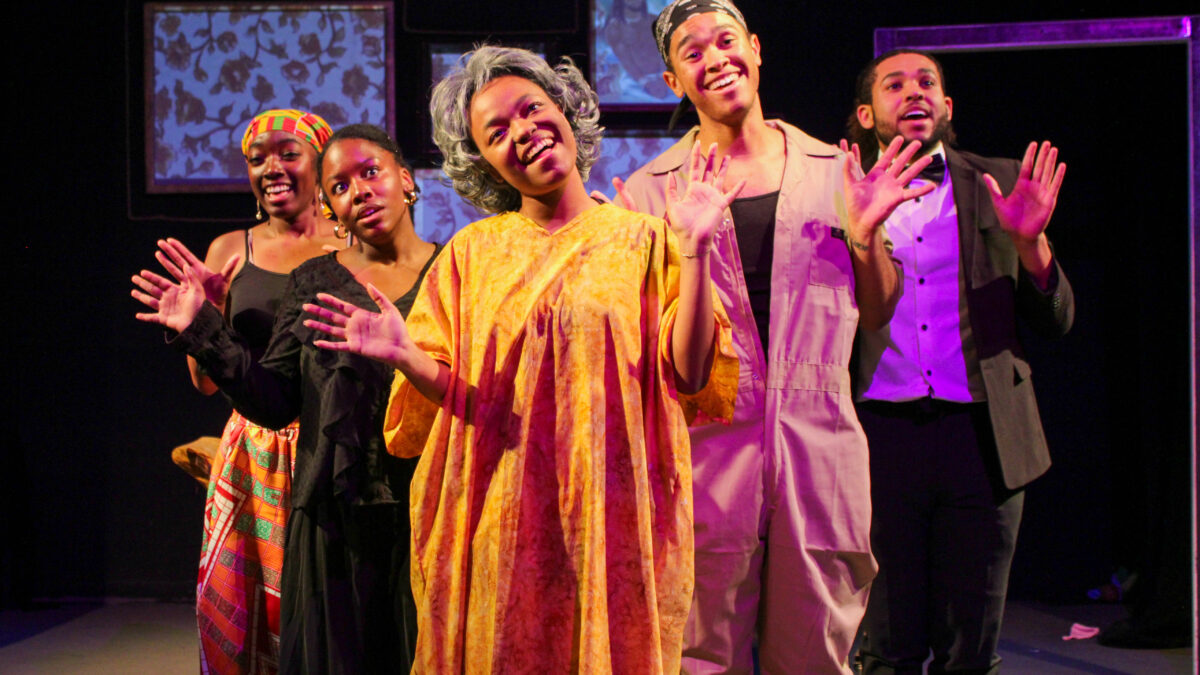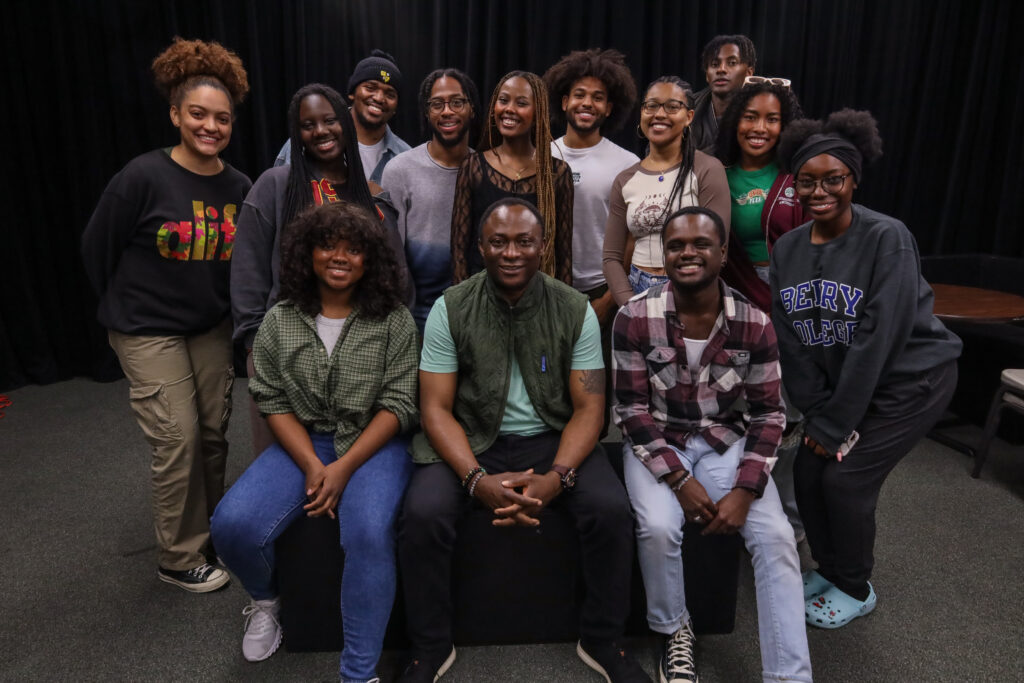
Members of the Black Art Collective performing The Colored Museum in November 2023. Photo by Hayley Bill, courtesy of the Black Art Collective.
In early November in the Massman Theatre, five sold-out performances of The Colored Museum entertained, provoked and intrigued. The play—written in 1986 by George C. Wolfe—is a unique piece of theatre, equally satirical and serious, in the form of a series of museum exhibits that critique Black culture in America. It was the latest production of the Black Art Collective, a new student group at USC that centers Black art and provides opportunities in many different disciplines for Black artists on campus. Jordan Freeman (BFA Film and Television Production ’25) is president and founder of the group.
“The reaction to The Colored Museum was amazing. The fact that it was sold out speaks to the excitement people have to see Black-centered work here at USC,” said Freeman. “I think they appreciated that the work is an in-community piece. That it’s a Black writer, a Black director—Kamryn Tate—and Black actors critiquing and celebrating Black culture at the same time.”
Freeman also acknowledges that bringing artists from many disciplines together strengthened the work of The Colored Museum. “I think the interdisciplinary approach that the Black Art Collective takes strengthens each individual piece of art we do,” Freeman said. “For example, for the design and graphics team for The Colored Museum, the fine arts department was able to contribute a lot to that.” This approach also allows Black artists on campus to gain experiences and try new mediums in a safe and supportive environment.
Neema Muteti (BFA Musical Theatre ’26) agrees. Muteti and co-chair Aneesa Monet (BFA Acting ’25) organize the theatrical wing of the Black Art Collective—other divisions include film, music, social/community, fine arts, dance and creative writing—putting on productions and educational workshops for Black artists on campus.
“It allows you to explore aspects of yourself artistically that aren’t necessarily what your major is focused on,” Muteti said. “You can grow as a multihyphenate and be actively working on those aspects of yourself, while still pursuing what you are educationally.”
The Black Art Collective was formed in the Spring 2023 semester over a series of informal coffee meetings between the chairs—Muteti compared the process with the Avengers assembling—which centered on frank discussions about the need for additional opportunities for Black artists to collaborate on campus. One unique aspect of the Black Art Collective is that they function as both an independent student production group, independently putting on performances like this semester’s The Colored Museum, and also host educational workshops for their members and anyone else who is interested in joining.
Although the group only formed recently, the number of productions and workshops they’ve put on for the community is impressive. Last semester the Black Art Collective’s educational branch featured workshops led by USC School of Dramatic Arts (SDA) faculty for Black artists including “Regarding Imaginative Play” with Anita Dashiell-Sparks, “Screen Acting” with Bayo Akinfemi and a monologue showcase that allowed Black actors to perform pieces they’d written themselves or long wanted to perform. Not slowing down, this semester they have hosted a SoulWork Panel and Talk Back with SDA faculty Danyé Brown and Natalie J. Gray and will host an introduction to comedy workshop and an audition workshop later in the semester.
Freeman notes that the support and generosity of Black faculty at SDA has been critical for the group’s ability to provide these educational workshops for the community.
“We’re incredibly thankful for the support we’ve had from Black faculty on campus, especially our faculty sponsor from SDA, Michele Shay,” Freeman said. “We’re only able to put on these workshops because professors continue to show up for us and continue to be invested in Black students. They give their own personal time to lead these workshops. I think the fact that we can offer these workshops allows people to start at an entry level into any artistic medium that they’d like to pursue.”

Creating comfort and confidence
Remaining affordable and accessible is also a major focus of the Black Art Collective, which has put measures in place to make sure that any artists wanting to join and benefit from the group’s educational or production opportunities are able to do so. Dues will be waived with no questions asked for those unable to afford them, and can also be put off to a later date if that’s a better arrangement. They have a price cap on all social events and their educational and production opportunities are always without cost to participants.
The Black Art Collective continues to look toward the future with ambitious plans to put on an expanding set of workshops and productions, as well as looking to build financial partnerships to put on more ambitious shows in the future.
“We would like to put on a production of Dreamgirls in the next academic year,” Freeman says. “The appeal of that show is both that it’s an extremely culturally important show for Black audiences, and the spectacle of the show is extremely important.”
All chair members are also currently in the process of writing manuals so that future generations of Black artists at USC can continue the group’s traditions after the current chairs—who are mostly third- and fourth-year students—graduate.
“The fear with starting a student organization is that once you graduate, it might not continue. We’re trying to put down enough roots so that it will,” Muteti said.
Kayla Campbell (BA Theatre ’25), who serves as assistant chair to Muteti, also hopes to see the Black Art Collective’s presence on campus grow and continue on after the current group of chairs graduates.
“I’d like us to expand on the divisions we have so that everyone can join in and get something out of the Black Art Collective,” Campbell said. “Even if they didn’t have the desire to do that art form before, maybe doing a workshop at the Black Art Collective inspires them and creates something new that we’ve never seen before.”
“It can be really isolating to be in a class and be the only Black person in the room,” Muteti said. Noting that the Black Art Collective hopes to create safe spaces where Black students can work with other artists who have shared experiences, she hopes that the Black Art Collective can help Black artists feel more confident to experiment with their art.
“Hopefully the comfort and the confidence that creates can translate in the way that Black artists move in other spaces.”